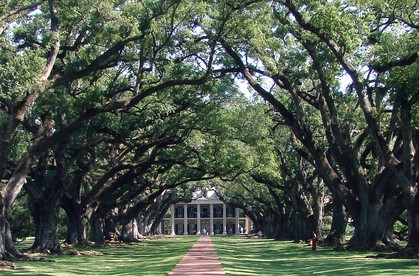 One of the icons of the deep South, the live oak is often shown draped with Spanish moss. Its huge massive size, wide-spreading horizontal branches, and stiff, glossy, leathery leaves make an imposing sight and provide welcoming shade. The leaves drop in the spring before the new growth appears so it provides interest all winter. Male catkins three to four inches long and female catkins one inch long are produced in spring on the same tree followed by 3/4-1” long acorns in fall. Southern live oak is resistant to wind and salt damage and stands up well in hurricanes. It is native to southeast Virginia south to Florida and west to southeast Texas and should not be confused with the California live oak (Q. agrifolia), that has holly-like evergreen leaves and is found in the hills and valleys of coastal California.
One of the icons of the deep South, the live oak is often shown draped with Spanish moss. Its huge massive size, wide-spreading horizontal branches, and stiff, glossy, leathery leaves make an imposing sight and provide welcoming shade. The leaves drop in the spring before the new growth appears so it provides interest all winter. Male catkins three to four inches long and female catkins one inch long are produced in spring on the same tree followed by 3/4-1” long acorns in fall. Southern live oak is resistant to wind and salt damage and stands up well in hurricanes. It is native to southeast Virginia south to Florida and west to southeast Texas and should not be confused with the California live oak (Q. agrifolia), that has holly-like evergreen leaves and is found in the hills and valleys of coastal California.
 Type: Evergreen tree
Type: Evergreen tree
Outstanding Feature: Growth form of mature tree
Form: Massive, wide spreading, horizontal branches
Growth Rate: Slow to moderate
Bloom: Sexes are separate but are produced on the same tree in spring; three to four inch male catkins; one inch female catkins; three-quarters to one inch acorn in fall
Size: 30-50’ H x 50-80’ W
Light: Full sun
Soil: Prefers average, moist, well-drained soil but tolerates a variety of soils types.
Hardiness: Zones 7b-10
Care: Low maintenance
Pests and Diseases: Susceptible to oak wilt, chestnut blight, oak decline syndrome, hypoxylon canker, bleeding canker, and acorn weevils; additional problems may develop when the trees are weakened or damaged.
Propagation: Seed.
